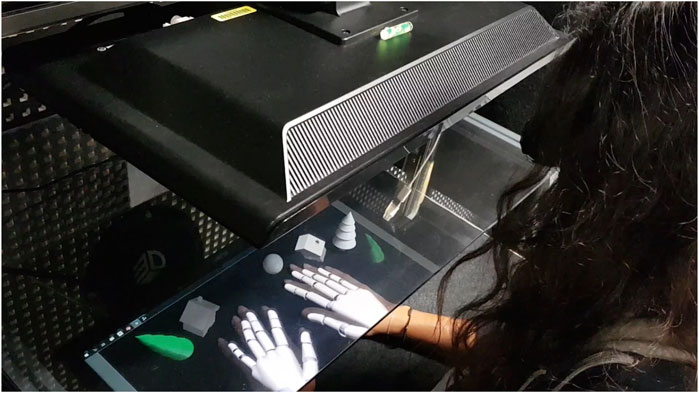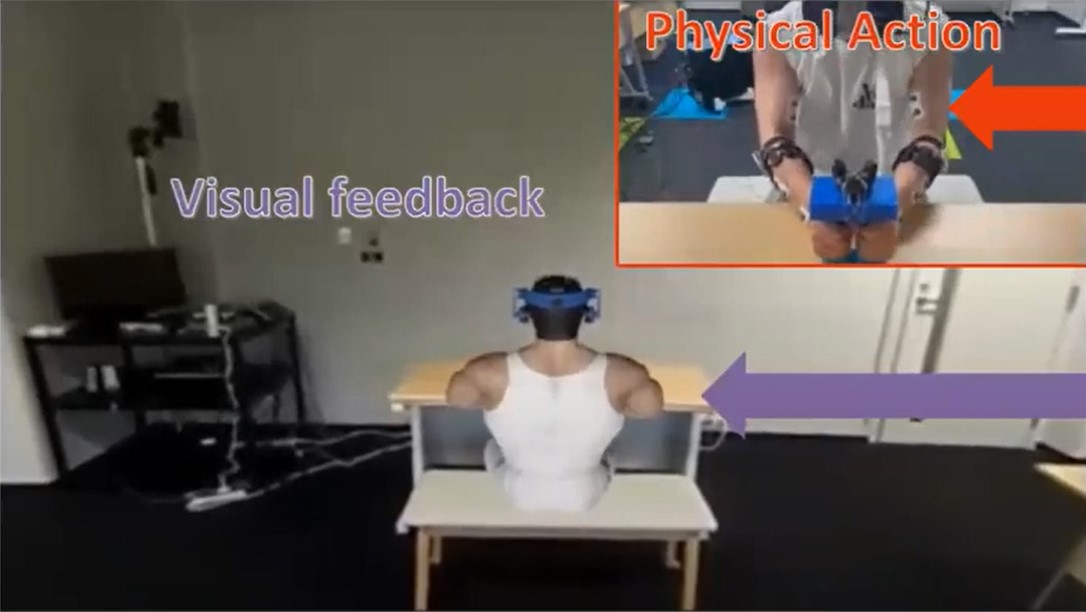Augmented reality (AR) allows users to see and embody virtual avatars within real environments. Once “avatarized”, it becomes
possible to change the appearance of one’s body and do things that would normally be impossible in the real world (extend one’s
arms, interact at a distance, etc.). While this opens doors to many applications, a lot of questions also arise about how the user
is impacted: indeed, avatars being powerful tools that can influence users’ cognition and behavior, little is known about their
effects within real life situations. The objectives of our research were the following:
- To identify factors influencing the sense of embodiment of avatars in AR,
- To explore the use of AR embodied avatars in everyday contexts,
- To design strategies to facilitate avatarization experiences.
Being an avatar “for real”: a literature review on virtual embodiment in Augmented Reality
![]()
Our research began with theoretical work to better understand and describe embodiment experiences. To do so, we established a
continuum of “body avatarization” providing a way to categorize embodiment systems based on the extent of the user’s virtual
representation [1, 2]. Using this continuum, we then reviewed the AR literature implementing avatar embodiment. This clarified the
technical aspects and challenges related to body avatarization in AR, the methods available to induce and measure the feeling of
embodiment, and the existing similarities between embodiment in AR and VR. On the other hand, we identified a lack of research on how
content displayed in AR influences the user’s perception of their avatars.
Virtual, real or mixed: how do the surrounding objects influence the sense of embodiment in Augmented Reality?

Within a user study [3], we investigated whether the mixed content of AR environments could affect embodiment illusions. Our study
compared the user’s sense of embodiment toward virtual robot hands embodied in the presence of different amounts of virtual and real
objects. To perform this experiment, we developed a transparent display system that allowed participants to see these hands superimposed
on their own hands. Our results show that participants felt a stronger sense of ownership of the virtual hands when they were viewed in
the presence of mixed virtual and real objects, compared to the case where the virtual hands were the only visible virtual content. This
suggests that the content of the environment should be taken into account when designing embodiment experiences. However, we could not
conclude with certainty about the origin of the observed differences and their extension to larger populations. Nevertheless, this
experiment should encourage the community to further explore the idea that the avatar itself is not the only moderator of the sense of
embodiment, but that the context and support of embodiment may also play a role.
Explore the possibilities of action in the real world with your avatar

Subsequently, we explored how body avatarization and AR can be combined for concrete use cases [4]. Drawing from theories on the perception
of affordances (action possibilities related to an environment and an individual), we proposed the concept of sending one’s avatar to act
remotely and improve our understanding of the physical world, as well as our action possibilities within it. To illustrate this idea, a
proof of concept allowing to manipulate an avatar whose shape and size correspond to those of the user was implemented. The avatar can be
controlled using three techniques: with a joystick, with manual interactions and with body tracking. We describe scenarios where each of
these techniques may be relevant and discuss their individual strengths and weaknesses within the scientific paper associated with this
research [4].
Perception of affordances with an Augmented Reality avatar

In three studies, we sought to assess the impact of controlling a third-person avatar in AR on the perception of real-world affordances [4, 7].
These experiments asked participants to take control of avatars (personalized to their size) to test different actions in the real world. The
first experiment showed that manipulating a virtual version of oneself can indeed improve the user’s accuracy and confidence when estimating his
or her action capabilities. The second experiment investigated how the memory of avatar manipulation can be exploited when reiterating the same
judgments once the avatar is no longer in view. We did not obtain evidence that having used an avatar had an impact on user performance, as we
found no significant differences between conditions that included prior avatar use and those that did not. The final experiment continued our
investigation of the resilient effects of avatars by asking users to estimate their ability to walk through a sliding door. We also compared
their accuracy when faced with a real door and when faced with a virtual door. We found no significant effects of the avatar, nor of the
virtuality of the door on the user’s performance. Nevertheless, from the first study, we retain that the experience gained through the avatar can
be used to make more informed decisions and to better understand the dimension of our environment.
Transition from the real to the virtual body: how to make it smooth? – Collaboration

In a project led by Riku Otono and Kiyoshi Kiyokawa of the Cybernetics and Reality Engineering (CARE) laboratory
(in Nara, Japan), we explored the use of graphical transitions to improve the continuity of the illusion of embodying a virtual body [5, 6].
The idea was to apply visual effects at different stages of the user’s avatarization to make it more fluid. In addition, we propose to first embody
an intermediate avatar that resembles the user before moving to the final avatar. Since it is not clear what types of transitions should be used,
we conducted a user study to compare two: active and passive transitions. In both cases, visual effects are applied to allow users to see their
avatar’s body change gradually. However, in active transitions, the user controls the progression of this change through his physical action while
in passive transitions, this change is applied automatically. In addition to comparing these two transitions, our experiment included two other
conditions in which a black screen was displayed during each type of transition to test the impact of viewing visual effects. Our results suggest
that graphical transitions do enhance the sense of embodiment and amplify the influence that the avatar has on its user, called the Proteus Effect.
We encourage future work to pursue this line of research with other types of avatars to verify the extension of these results.
Reinforcing the illusion of embodiment through mental preparation – Collaboration

Since the sense of embodiment is not always easy to evoke across users and avatars, we investigated strategies to enhance embodiment illusions
and reduce variability caused by individual characteristics [7]. This research was conducted in a collaborative manner with the
CARE lab . Together, we investigated ways to exploit the different phases of embodiment experiences,
and in particular, the time spent before embodiment to enhance the illusion of having another body at the time of avatarization. We conducted a
user study evaluating how the user’s mental preparation can help create stronger illusions. The experiment was conducted in VR with an avatar
representing Hulk, a character from the Marvel franchise. Before embodying him, participants performed an imagination and acting exercise that we
designed to help them get into the skin of their avatar. The results of this experiment are still being analyzed. The first tests did not show a
significant effect of this mental preparation on the feeling of embodiment. However, we could see positive effects on the overall user experience:
participants felt stronger and were less aware of the environment around them. Further analysis is in progress.
Videos
Publications
[1] Adélaïde Genay, Anatole Lécuyer, Martin Hachet. “Incarner un Avatar en Réalité Augmentée : Revue de la Littérature”. WACAI 2020 – Workshop
sur les Affects, Compagnons artificiels et Interactions, CNRS, Université Toulouse Jean Jaurès, Université de Bordeaux, Jun 2020, Saint Pierre
d’Oléron, France. HAL: hal-02933477
[2] Adélaïde Genay, Anatole Lécuyer, Martin Hachet. “Being an Avatar “for Real”: A Survey on Virtual Embodiment in Augmented Reality”. IEEE
Transactions on Visualization and Computer Graphics (TVCG), Christchurch, New Zealand, Jul. 2021. DOI:
10.1109/TVCG.2021.3099290
[3] Adélaïde Genay, Anatole Lécuyer, Martin Hachet. “Virtual, Real or Mixed: How Surrounding Objects Influence the Sense of Embodiment in
Optical See-Through Experiences?” Frontiers in Virtual Reality, Frontiers, 2021, 2, pp.1-15. DOI:
10.3389/frvir.2021.679902
[4] A. Genay, A. Lécuyer and M. Hachet, “What Can I Do There? Controlling AR Self-Avatars to Better Perceive Affordances of the Real World”,
IEEE International Symposium on Mixed and Augmented Reality (ISMAR), Singapore, Singapore, Oct. 2022. DOI:
10.1109/ISMAR55827.2022.00061
[5] R. Otono, A. Genay, M. Perusquía-Hernández, N. Isoyama, H. Uchiyama, M. Hachet, A. Lécuyer, K. Kiyokawa, “Studying “Avatar Transitions” in
Augmented Reality: Influence on Sense of Embodiment and Physiological Activity”, IEEE International Symposium on Mixed and Augmented Reality
(ISMAR), Singapore, Singapore, Oct. 2022. DOI:
10.1109/ISMAR-Adjunct57072.2022.00106
[6] R. Otono, A. Genay, M. Perusquía-Hernández, N. Isoyama, H. Uchiyama, M. Hachet, A. Lécuyer, K. Kiyokawa, “I’m Transforming! Effects of
Visual Transitions to Change of Avatar on the Sense of Embodiment in AR”, IEEE Conference on Virtual Reality and 3D User Interfaces (VR),
Shanghai, China, Mar. 2023. In publication process. HAL: hal-03968274
[7] Genay, A., “Being a virtual avatar in a real environment: Design and study of Avatar embodiment in augmented reality” (Thèse), Université
de Bordeaux. Available at: https://theses.hal.science/tel-04004116
Pop science
Oct. 2021. Article by Adélaïde Genay: “Les avatars peuvent-ils remplacer nos corps ?”, The Conversation (Talence, France).
Lien.
Juin 2021. Participation of Adélaïde Genay to the podcast “Thèse et Vous !”, episode 9 (Talence, France).
Lien.
Mars 2021. Presentation by Adélaïde Genay at the “3-Minute thesis” contest (Talence, France) ».
Lien.
Fév. 2020. Round table, “De l’être humain à l’être virtuel : quelle relation entretenons-nous avec nos avatars” (Pessac, France).






